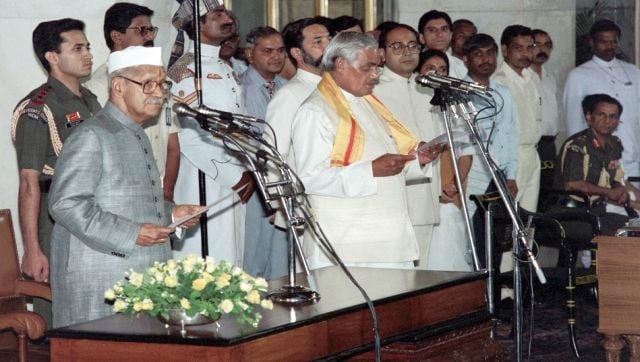Britain’s Liz Truss had 45 days in office, Atal Bihari Vajpayee had 16… The world’s shortest-serving leaders
On 6 September, Britain got a new prime minister when Queen Elizabeth II formally appointed Liz Truss.
Forty-five days later, on 20 October, after a disastrous time in Downing Street, she announced her resignation, saying, “I cannot deliver the mandate on which I was elected by the Conservative Party. I have therefore spoken to His Majesty the King to notify him that I am resigning as leader of the Conservative Party.”
With this, 47-year-old Truss earned the ignominy of becoming the shortest-serving leader in British history — a joke made by a British tabloid asking if she would wilt faster than a lettuce actually came true.
However, there have been a few other world leaders who have lasted far less than Truss’ 45 days. Here’s a look at these other short tenures, which may provide little comfort to Truss and make her time in office look positively lengthy.
Britain’s prime ministers
Until Thursday when Liz Truss resigned, Tory statesman George Canning held the distinction of holding the UK record, serving 119 days in office before dying of tuberculosis on 8 August 1827.
The Guardian reports that Canning, who held many senior government posts in his time is remembered for his part in such an extreme example of Cabinet infighting that Truss’s woes pale in comparison.

Then there was Frederick John Robinson, Viscount Goderich, appointed by King George IV. He survived just 144 days (31 August 1827 to 21 January 1828) before quitting as he failed to solidify the Tory-Whig coalition at the time. He was nicknamed “The Blubberer” for he would often burst into tears when under stress.
Tory party’s Alec Douglas-Home lasted 363 days before being replaced by Harold Wilson. Douglas-Home left office after he was defeated by Labour’s Harold Wilson in the 1964 general election.
PMs with short tenures across the world
In India, Atal Bihari Vajpayee has earned the distinction of serving as prime minister for 16 days from 16 May to 1 June 1996. The Bharatiya Janata Party stalwart stepped down ahead of a trust vote, asserting, “We assure you that while you want power, we want to work for this country and we will never sit and rest in this endeavour.”
Vajpayee stuck to his assurance — he came back to power for a second term in 1998, and lasted for the next 13 months, only to be plopped back to prime minister’s post in 1999, this time seeing it to its conclusion.

If Vajpayee’s time of 16 days is short, then Gulzarilal Nanda’s time in office as caretaker prime minister is even shorter — he served twice for 13 days each after the deaths of Jawaharlal Nehru (may-June 1964) and his successor Lal Bahadur Shastri (January 1966) died.
In 1967, Siaka Stevens of Sierra Leone became prime minister after winning a closely contested election. However, this did not go well and the military was sent in to arrest Stevens, an hour after he was sworn in. This makes him one of the shortest-serving leaders in the world.
However, two weeks later, there was a counter-coup, and Stevens reclaimed his position. He served for 17 years, making him one of the longest-serving heads of state.
Other heads of state
In the United States, President William Henry Harrison lasted just a month in office — dying on his 32nd day – after delivering an inaugural address that lasted about two hours as the ninth commander-in-chief. Harrison also became the first to die in office.
Harrison’s doctor, Thomas Miller, declared that he died of “pneumonia of the lower lobe of the right lung, complicated by congestion of the liver,” according to the New York Times.

Meanwhile, Mexican President Pedro Lascurain didn’t even make it to one hour in 1913 after a military coup led by General Victoriano Huerta, who kicked the former Mexico City mayor out of office, the Guardian reported. Lascuráin’s time as president is estimated to have lasted a mere 45 minutes.
In Nazi Germany, Joseph Goebbels technically became chancellor for one night after Adolf Hitler killed himself on 30 April 1945. However, Goebbels made a quick exit when he and his wife, Magda, poisoned their six kids before dying of suicide.
Kings and queens
It’s not just world leaders that have seen short tenures. France’s King Louis XIX takes the cake as he was ruler for a full 20 minutes! Having spent most of his time away from France, Louis Antoine returned home to fight against Napoleon in the 1810s. However, his 20 minutes of fame came in 1830 when he took office after his father’s abdication. He soon stepped down too.
King Louis XIX can take respite that he shares the shortest time as king with Luís II of Portugal. He technically became king on 1 February 1908, after his father, Carlos I, was murdered in the Lisbon regicide. He, too, was fatally wounded at the same time but reportedly survived his father by roughly 20 minutes.

Faring a little better on the longevity scale was Lady Jane Gray, an English noblewoman known as the “Nine Days Queen” after she claimed the throne of England, Wales, and Ireland at the tender age of 16 from 10 to 19 July in 1553. She was executed the following year after the country opted for Mary, the daughter of Henry VIII with Catherine of Aragon.
Another short period on the throne was that of Michael II, who lasted about 18 hours in Russia after the abdication of his brother Tsar Nicholas II in March 1917. He was later thrown in prison and murdered after the revolution.
With inputs from agencies
Read all the Latest News, Trending News, Cricket News, Bollywood News,
India News and Entertainment News here. Follow us on Facebook, Twitter and Instagram.
from Firstpost India Latest News https://ift.tt/2gauspC
FP Explainers
Comments
Post a Comment